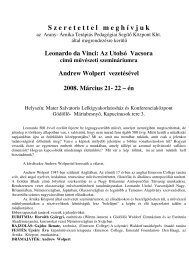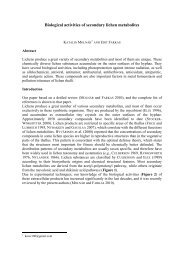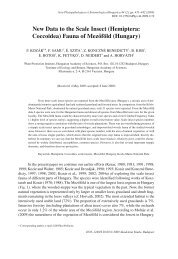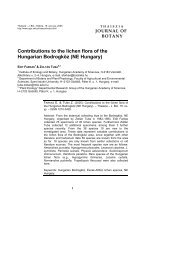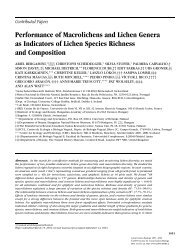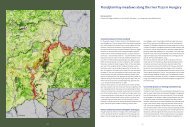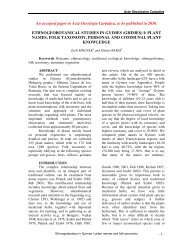Current Results on Biological Activities of Lichen ... - Lichens and Me
Current Results on Biological Activities of Lichen ... - Lichens and Me
Current Results on Biological Activities of Lichen ... - Lichens and Me
You also want an ePaper? Increase the reach of your titles
YUMPU automatically turns print PDFs into web optimized ePapers that Google loves.
160 K. Molnár <strong>and</strong> E. Farkas · <strong>Biological</strong> <strong>Activities</strong> <strong>of</strong> <strong>Lichen</strong> Substances<br />
lichen metabolites are derived from the acetylpolymal<strong>on</strong>yl<br />
pathway (including the polyketide<br />
pathway), while others originate from the meval<strong>on</strong>ic<br />
acid <strong>and</strong> shikimic acid pathways.<br />
The Development <strong>of</strong> Analytical <strong>Me</strong>thods (<strong>and</strong><br />
their Applicati<strong>on</strong> in <strong>Lichen</strong>ology)<br />
Nyl<strong>and</strong>er (1866) was the first lichenologist to<br />
use chemistry for tax<strong>on</strong>omical purposes. He detected<br />
the presence <strong>of</strong> various lichen substances<br />
by color spot tests. In the early 20th century, Zopf<br />
(1907) <strong>and</strong> Hesse (1912) described numerous lichen<br />
compounds, mostly without their structural<br />
characterizati<strong>on</strong>, as organic chemistry was in its<br />
infancy (Shibata, 2000). Asahina developed the<br />
microcrystallizati<strong>on</strong> technique to identify lichen<br />
metabolites (Asahina, 1936 – 1940). This simple<br />
<strong>and</strong> rapid technique allowed lichenologists to<br />
identify the major c<strong>on</strong>stituents in hundreds <strong>of</strong><br />
lichen species, but it was not useful for detecting<br />
minor comp<strong>on</strong>ents <strong>and</strong> analyzing mixtures <strong>of</strong><br />
lichen substances. In 1952, Wachtmeister introduced<br />
paper chromatography for the separati<strong>on</strong><br />
<strong>and</strong> characterizati<strong>on</strong> <strong>of</strong> lichen substances. Mitsuno<br />
(1953) explained the relati<strong>on</strong>ship between<br />
the chemical structures <strong>of</strong> lichen compounds <strong>and</strong><br />
their paper chromatographic Rf values. Since paper<br />
chromatography could not always separate<br />
individual compounds, Ramaut (1963a, b) began<br />
using thin layer chromatography (TLC) with<br />
Pastuska’s solvent phase for depsides <strong>and</strong> depsid<strong>on</strong>es.<br />
According to Lumbsch (1998), the vast majority<br />
<strong>of</strong> lichen sec<strong>on</strong>dary metabolites, especially<br />
substances which are unique to lichens, bel<strong>on</strong>g to<br />
these two groups.<br />
TLC has been used to study specific groups <strong>of</strong><br />
lichen products (Bendz et al., 1965, 1966, 1967;<br />
Santess<strong>on</strong>, 1965, 1967a, b). Different authors used<br />
different solvent systems <strong>and</strong> chromatographic<br />
c<strong>on</strong>diti<strong>on</strong>s, making it impossible to compare their<br />
results. This problem was solved when a st<strong>and</strong>ardized<br />
method was developed by Chicita F. Culbers<strong>on</strong><br />
<strong>and</strong> Hör-Dur Kristinss<strong>on</strong> in 1970. They<br />
introduced Rf classes, which depend <strong>on</strong>ly <strong>on</strong> the<br />
relative order <strong>of</strong> spots, <strong>and</strong> which are more reliably<br />
c<strong>on</strong>stant. This st<strong>and</strong>ardized method has<br />
been used for routine analyses <strong>of</strong> lichen products<br />
in chemotax<strong>on</strong>omic <strong>and</strong> phytochemical studies,<br />
with various updates over time (Culbers<strong>on</strong>,<br />
1972b, 1974; Culbers<strong>on</strong> <strong>and</strong> Johns<strong>on</strong>, 1976, 1982;<br />
Culbers<strong>on</strong> et al., 1981). Later the use <strong>of</strong> high-performance<br />
thin layer chromatography (HPTLC) in<br />
screening lichen substances was developed (Arup<br />
et al., 1993). HPTLC is more sensitive, allows the<br />
running <strong>of</strong> more samples in a shorter period <strong>of</strong><br />
time, <strong>and</strong> requires smaller amounts <strong>of</strong> solvent. Because<br />
<strong>of</strong> its simplicity, this technique has become<br />
the most widely used microchemical method for<br />
identifying lichen substances (Fig. 3).<br />
The first use <strong>of</strong> high-performance liquid chromatography<br />
(HPLC) <strong>on</strong> crude lichen extracts was<br />
tried by Culbers<strong>on</strong> (1972a), because most <strong>of</strong> the<br />
sec<strong>on</strong>dary natural products <strong>of</strong> lichens have low<br />
volatility <strong>and</strong> low thermal stability, <strong>and</strong> thus gas<br />
chromatography is not able to analyze them. She<br />
used normal-phase silica columns <strong>and</strong> isocratic<br />
eluti<strong>on</strong> with mobile phases <strong>of</strong> mixtures <strong>of</strong> hexane,<br />
isopropyl alcohol <strong>and</strong> acetic acid. Reversephase<br />
HPLC was first used for the separati<strong>on</strong><br />
<strong>of</strong> orcinol <strong>and</strong> β-orcinol depsides <strong>and</strong> depsid<strong>on</strong>es<br />
<strong>on</strong> a C18 column <strong>and</strong> with a water/methanol/<br />
acetic acid mobile phase (Culbers<strong>on</strong> <strong>and</strong> W. L.<br />
Culbers<strong>on</strong>, 1978a; W. L. Culbers<strong>on</strong> <strong>and</strong> Culbers<strong>on</strong>,<br />
1978b).<br />
Although these isocratic methods yielded excellent<br />
results for the separati<strong>on</strong> <strong>and</strong> identifica-<br />
Fig. 3. <strong>Lichen</strong> substances <strong>on</strong> an HPTLC plate developed<br />
in solvent system B (cyclohexane/methyl tert-butyl<br />
ether/formic acid, 6.5:5:1) after being treated with sulfuric<br />
acid (according to Arup et al., 1993). A, atranorin<br />
(c<strong>on</strong>trol); Z, zeorin (c<strong>on</strong>trol); N, norstictic acid (c<strong>on</strong>trol);<br />
P, physodic acid; O, oxyphysodic (= 3-hydroxyphysodic)<br />
<strong>and</strong> physodalic acids; Pr, protocetraric acid. (Scanned<br />
image.)



